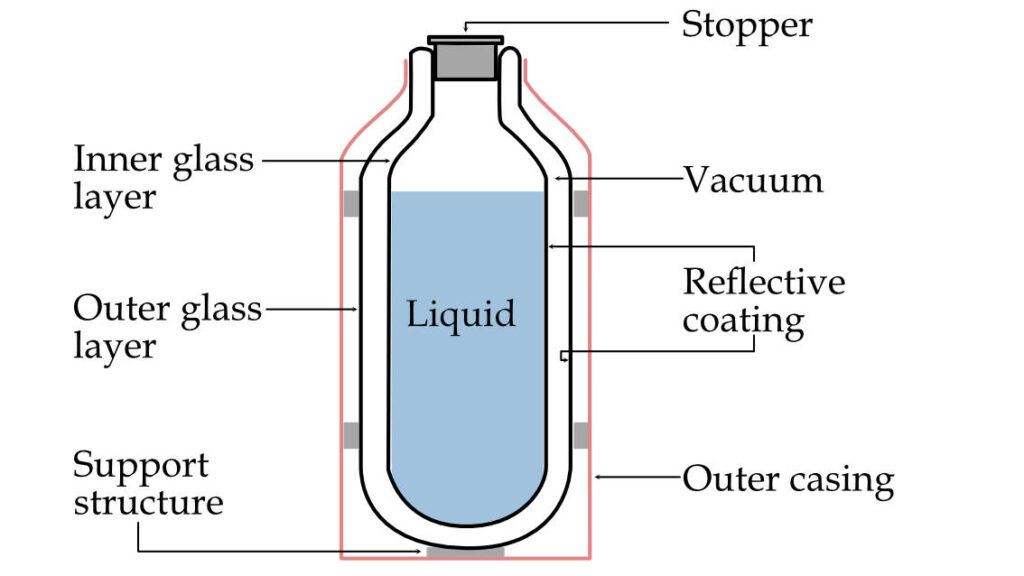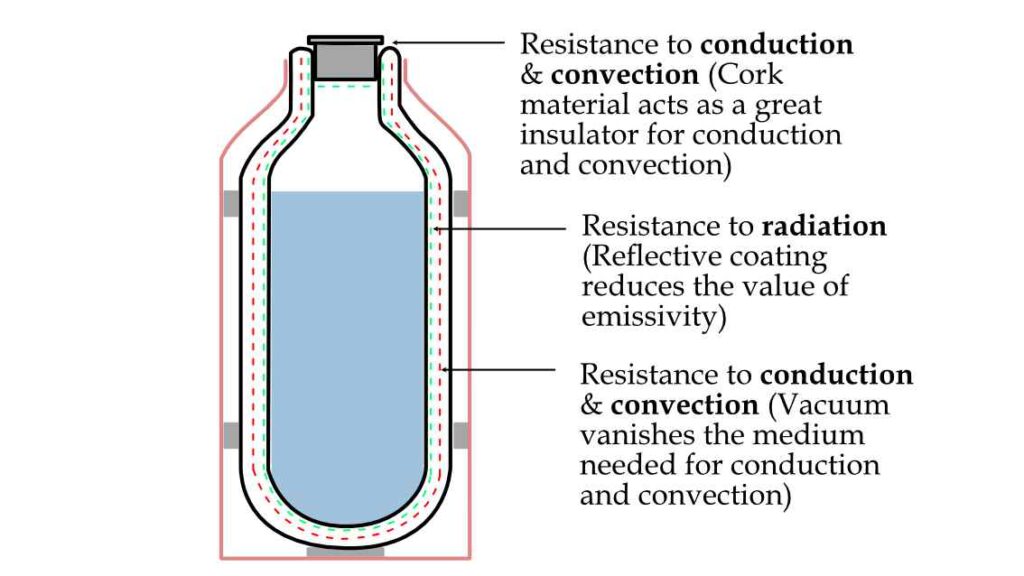Who doesn’t like a hot cup of coffee or tea on a cold winter evening or having a chilling cold drink on hot summer days? But, the laws of nature always try to bring things into equilibrium. And we prevent this possibility through inventions. A Thermos flask is one such invention that keeps your hot liquid hot and cold liquid cold. The physics behind thermos flask is closely related to heat transfer physics.
What is a Thermos flask?
Thermos flask, also known as a vacuum or Dewar-flask, is a double-walled glass vessel; that minimizes the heat transfer between the fluid inside and the surrounding outside. It keeps a hot liquid hot and a cold liquid cold for an extended period.

Key components of vacuum flask
You already know that to reduce the heat transfer, you must increase the resistance to heat transfer. As a result, insulating materials that minimize heat transfer through conduction, convection, and radiations come into the application.
Here, you can see what is inside any vacuum flask:
- Outer casing: Outer casing made of plastic or stainless steel protects the glass walls.
- The outer layer of glass or stainless steel: The inner portion of this glass layer coated with reflective material reflects any incoming radiation.
- Vacuum space: This space maintained at almost a vacuum prevents heat convection.
- The inner layer of glass or stainless steel: The outer portion of this glass layer coated with reflective material prevents heat transfer through radiation.
- Plastic or cork stopper: The stopper made of plastic or cork acts as a seal to prevent fluid from going out and as insulation for heat conduction and convection.
- Support structure: The structure made of insulation material acts as a rigid connector that keeps the inner and outer flask rigidly in its place.
- Additional insulation layer (Optional): The space between the glass vessel and the metal or plastic case contains heat-insulating material like heat or plastic to prevent heat transfer conduction further.
Physics behind Thermos flask
A thermos flask is nothing but one bottle inside another bottle, separated by a vacuum layer in between. The vacuum layer prevents heat transfer through conduction and convection; since conduction and convection require the presence of any medium to transfer heat. And as a result, radiation is the only possible way of heat transfer remaining. The outer part of the inner glass layer and the inner part of the outer glass layer are coated with reflecting material. The reflective coating minimizes the emissivity or absorptivity of the material. And it acts as a poor radiator and a good reflector of heat radiation.
The Stefan-Boltzmann equation shows that the heat transfer Q through radiation is directly proportional to the material’s emissivity ε.
$$Q = \varepsilon \sigma A T_s^4$$
Thus, coating with the reflective layer reduces the emissivity value and decreases the radiation heat transfer.
The additional insulating material between the outer glass layer and the casing further adds resistance to conduction heat transfer.
As a result, to minimize the heat transfer from the liquid to the atmosphere outside the thermos flask and vice versa, the thermos flask restricts all modes of heat transfer. The conduction is prevented by inserting a thermally insulating material, convection is prevented by inserting the vacuum layer, and radiation is prevented by coating reflecting material on the glass surfaces.
Different layers in the thermos flask act as resistance to all the modes of heat transfer, as shown in the figure below.

History
The application of thermo-flask is not limited to household purposes but extends to scientific labs and experiments. Also known as the Dewar flask, Scottish scientist Sir James Dewar invented the thermos flask in 1892. Dewar worked in cryogenics (science that deals with phenomena at low temperatures) and needed vessels to store chemicals at extremely low temperatures and in stable conditions. Therefore it leads to the invention of the flask; by placing one glass bottle in another larger one and evacuating the air between the bottles.
Conclusions
A thermos flask, a double-walled glass vessel, keeps hot fluid hot and cold fluid cold for an extended period. It contains a combination of layers that prevent heat transfer due to conduction, convection, and radiation.
The key learnings from this post:
- Vacuum layer: The vacuum layer prevents the heat transfer through conduction and convection. The lack of medium ensures that there is no conduction and convection.
- Reflective coating: The reflective coating on the glass ensures that there is no radiation heat transfer. The reflective coating reduces the value of emissivity of the material.

Android Apps
⭐️ ⭐️ ⭐️ ⭐️ ⭐️ 1000+ | 400,000 + Downloads (Cumulative)
At eigenplus, our goal is to teach civil engineering students about structural analysis and design starting from the fundamental principles. We do this with the help of interactive android applications and accompanying web articles and videos.
Our apps have helped more than 400 thousand students across the world to understand and learn the concepts of structural engineering. Check out our apps on the google play store.
QB
What is the function of the three tablets found in the vacuum of the flask? We were advised that it’s cancer tabs
Thank you dear Dicsin, for reading the articles. Yes the three tablets which are there in the thermo flask are kind of carcinogenic as most of the time they are “asbestos”. The reason for using asbestos in thermo flask is, that they are very high heat resistance they not change their form. Coming to your first question the function of the tablets are to maintain the gap between inner and outer layer. Hence thermo flask is safe.